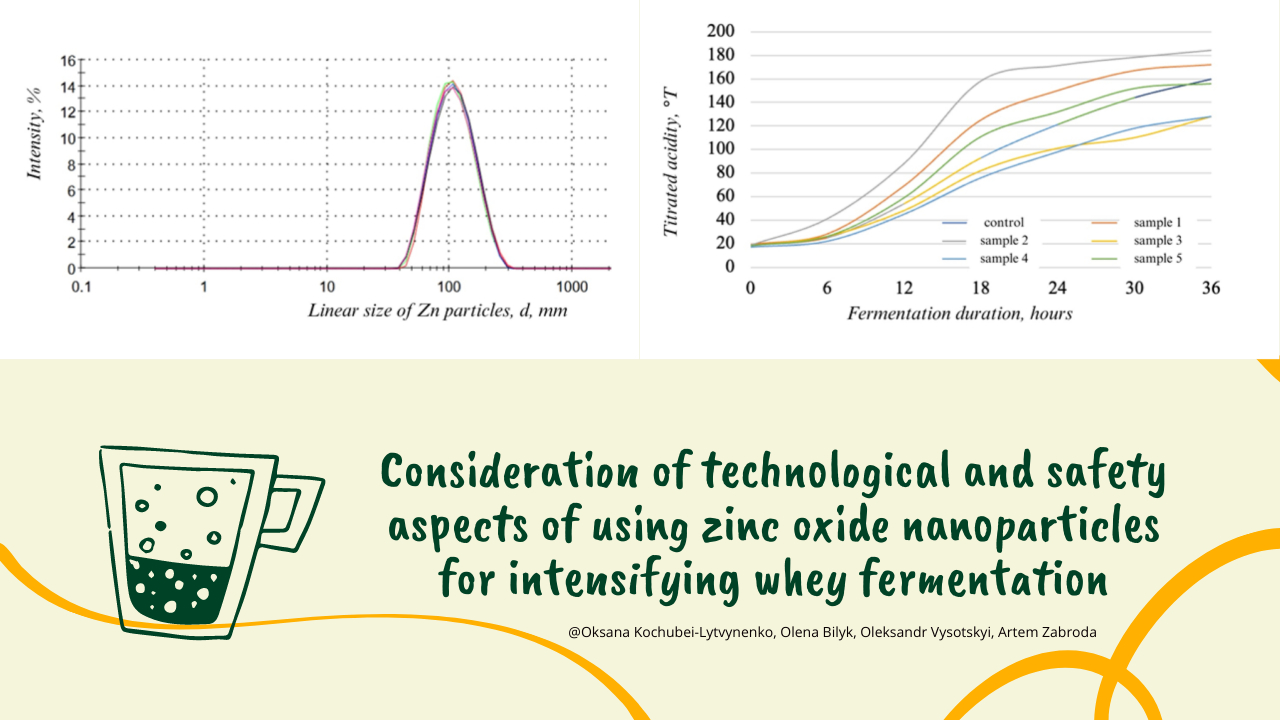Consideration of technological and safety aspects of using zinc oxide nanoparticles for intensifying whey fermentation
DOI:
https://doi.org/10.15587/2706-5448.2024.310354Keywords:
whey, lactic acid, zinc oxide nanoparticles, whey fermentation, intensification, cytotoxicity of nano-ZnOAbstract
The study is dedicated to using zinc oxide nanoparticles (ZnO) to intensify the fermentation of whey, an important resource in the food industry. Traditional methods of whey fermentation take a lot of time and require significant resources, reducing their economic efficiency. This study found that the addition of ZnO nanoparticles significantly accelerates the fermentation process. Treating whey with the electro-spark method for 60 seconds allowed achieving the necessary acidity level (160±10 °T) in 18 hours, almost twice as fast as traditional methods, which take up to 36 hours. ZnO nanoparticles also improve the activity of lactic acid bacteria and increase the bactericidal ability of macrophages, which contributes to the overall efficiency of the fermentation process.
The use of ZnO nanoparticles in whey production can significantly improve the efficiency of the technological process, reducing fermentation time and improving the quality of the final product. This opens up new prospects for medium and small enterprises looking to improve the economic efficiency of their operations.
In addition to accelerating fermentation, ZnO nanoparticles have additional advantages in terms of product safety and quality. The study showed that ZnO nanoparticles enhance the antioxidant properties of fermented products, which is important for maintaining their freshness and nutritional value. The high reactivity of ZnO nanoparticles allows them to interact with bacterial membrane receptors, increasing their metabolic activity and resistance to external factors.
Thus, the study demonstrates the significant potential of using ZnO nanoparticles to intensify the whey fermentation process, contributing to more efficient production of food products and ensuring their high quality. This is especially important in modern conditions of limited resources and growing demands for economic efficiency and food safety. The introduction of ZnO nanoparticles into production processes can be a key step in improving fermentation technologies and increasing the competitiveness of food products in the market.
References
- Statystychni dani vyrobnytstva promyslovoi produktsii za vydamy za 2020 i 2021 roky. Available at: http://www.ukrstat.gov.ua/ Last accessed: 10.06.2024
- Pyroh, T. P. (2010). Zahalna mikrobiolohiia. Kyiv: NUKhT, 632.
- Stehlik-Tomas, V., Zetic, V. G., Stanzer, D., Grba, S., Vahcic, N. (2004) Zinc, Copper and Manganese Enrichment in Yeast Saccharomyces cerevisiae. Food Technology and Biotechnology, 42 (2), 115–120.
- Meng, Y., Liang, Z., Yi, M., Tan, Y., Li, Z., Du, P. et al. (2022). Enrichment of zinc in Lactobacillus plantarum DNZ-4: Impact on its characteristics, metabolites and antioxidant activity. LWT, 153, 112462. https://doi.org/10.1016/j.lwt.2021.112462
- Karputina, M. V., Romanova, Z. M., Sydor, V. M., Karputina, D. D. (2012) Suchasni sposoby aktyvatsii protsesiv rozmnozhennia ta fermentatsii pyvovarnykh drizhdzhiv. Obladnannia ta tekhnolohii kharchovykh vyrobnytstv, 28, 125–130.
- Koshova, V. M., Yazhlo, V. S., Kaplunenko, V. H., Ohorodnyk, Yu. I. (2015). Increase of fermentative activity of brewing yeast using zinc nanoaquachelate. Eastern-European Journal of Enterprise Technologies, 4 (10 (76)), 40–44. https://doi.org/10.15587/1729-4061.2015.47888
- Kochubei-Lytvynenko, O., Chernyushok, O., Bilyk, O., Bondarenko, Y. (2019). Studying the effect of electrospark treatment of milk whey on the process of its fermentation and quality of thermoacid cheese. Eastern-European Journal of Enterprise Technologies, 6 (11 (102)), 33–40. https://doi.org/10.15587/1729-4061.2019.183712
- Chasapis, C. T., Loutsidou, A. C., Spiliopoulou, C. A., Stefanidou, M. E. (2011). Zinc and human health: an update. Archives of Toxicology, 86 (4), 521–534. https://doi.org/10.1007/s00204-011-0775-1
- González-Weller, D., Paz-Montelongo, S., Bethencourt-Barbuzano, E., Niebla-Canelo, D., Alejandro-Vega, S., Gutiérrez, Á. J. et al. (2023). Proteins and Minerals in Whey Protein Supplements. Foods, 12 (11), 2238. https://doi.org/10.3390/foods12112238
- Chekman, I. S., Ulberh, Z. R., Rudenko, A. D. et al. (2013) Tsynk i nanotsynk: vlastyvosti, zastosuvannia u klinichnii praktytsi. Ukrainskyi medychnyi chasopys, III/IV (2 (94)), 42–47.
- Jiang, J., Pi, J., Cai, J. (2018). The Advancing of Zinc Oxide Nanoparticles for Biomedical Applications. Bioinorganic Chemistry and Applications, 2018, 1–18. https://doi.org/10.1155/2018/1062562
- Kochubei-Lytvynenko, O. V., Lopatko, K. H. (2021) Nanobiotekhnolohichni osnovy spriamovanoho zbahachennia molochnoi syrovatky mineralnymy elementamy. Naukovi pratsi NUKhT, 5, 134–148.
- Lopatko, K. H., Aftandiliants, Ye. H., Zazymko, O. V., Trach, V. V. (2016). Fizyka, syntez ta biolohichna funktsionalnist nanorozmirnykh obiektiv. Kyiv: Vyd-vo NUBiP Ukrainy, 615.
- Sharma, V., Anderson, D., Dhawan, A. (2012). Zinc oxide nanoparticles induce oxidative DNA damage and ROS-triggered mitochondria mediated apoptosis in human liver cells (HepG2). Apoptosis, 17 (8), 852–870. https://doi.org/10.1007/s10495-012-0705-6
- Dmytrukha, N. M., Luhovskyi, S. P., Lahutina, O. S. (2015) Toksychnyi efekt nanochastynok oksydu zaliza na perytonealni makrofahy shchuriv. Ukrainskyi zhurnal z problem medytsyny pratsi, 3, 28–33.
- Kharazian, B., Hadipour, N. L., Ejtehadi, M. R. (2016). Understanding the nanoparticle–protein corona complexes using computational and experimental methods. The International Journal of Biochemistry & Cell Biology, 75, 162–174. https://doi.org/10.1016/j.biocel.2016.02.008
- Wahab, R., Siddiqui, M. A., Saquib, Q., Dwivedi, S., Ahmad, J., Musarrat, J. et al. (2014). ZnO nanoparticles induced oxidative stress and apoptosis in HepG2 and MCF-7 cancer cells and their antibacterial activity. Colloids and Surfaces B: Biointerfaces, 117, 267–276. https://doi.org/10.1016/j.colsurfb.2014.02.038

Downloads
Published
How to Cite
Issue
Section
License
Copyright (c) 2024 Oksana Kochubei-Lytvynenko, Olena Bilyk, Oleksandr Vysotskyi, Artem Zabroda

This work is licensed under a Creative Commons Attribution 4.0 International License.
The consolidation and conditions for the transfer of copyright (identification of authorship) is carried out in the License Agreement. In particular, the authors reserve the right to the authorship of their manuscript and transfer the first publication of this work to the journal under the terms of the Creative Commons CC BY license. At the same time, they have the right to conclude on their own additional agreements concerning the non-exclusive distribution of the work in the form in which it was published by this journal, but provided that the link to the first publication of the article in this journal is preserved.







